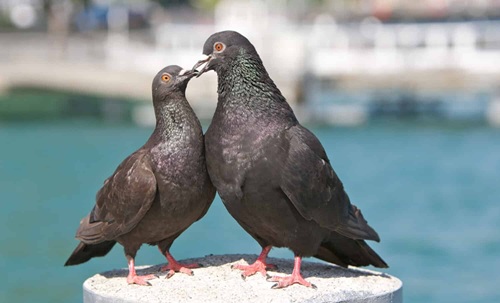Pigeons are among the most common and beloved birds in India, found in cities, villages, and even in households as pets or racing birds. For breeders, hobbyists, and pet owners, knowing whether a pigeon is male or female is essential for breeding, behavior understanding, and proper care. However, unlike many animals, male and female pigeons look very similar, making identification a challenge. This guide explains how to identify male and female pigeons using physical characteristics, behavior, and subtle cues.

1. Understanding Male and Female Pigeons
- Male pigeons (cocks): Generally slightly larger, stronger, and more robust than females. They are responsible for territorial defense, courtship, and mating behaviors.
- Female pigeons (hens): Slightly smaller and leaner, often less aggressive. Females are responsible for egg-laying, incubation, and nurturing young chicks.
Understanding these roles can help in observing natural behavior patterns, which is a key clue in distinguishing the sexes.
2. Physical Characteristics
a) Size and Body Structure
- Males are usually bigger and heavier, with a broader chest and thicker neck.
- Females are smaller and more delicate, with a slimmer body.
b) Head and Beak
- Male pigeons often have a slightly larger head with a more prominent cere (the fleshy area above the beak).
- Female pigeons have a smaller head, and the cere appears less pronounced.
c) Feathers and Plumage
- Both male and female pigeons may have similar feather colors, but males sometimes have brighter, shinier, or more iridescent neck feathers during the breeding season.
- Female feathers are generally less vibrant and smooth.
3. Behavioral Differences
Behavior is often the most reliable way to identify male and female pigeons, especially for adults.
- a) Male Pigeons
- Exhibit courtship behavior, such as cooing, puffing up the chest, strutting, and circling the female.
- Males often defend their territory or perch, showing dominance over other males.
- May peck or chase other pigeons to assert dominance.
- b) Female Pigeons
- Usually accepts the male’s courtship, often standing still or reciprocating lightly.
- Females are primarily responsible for nesting, egg-laying, and caring for chicks.
- Less aggressive and rarely engages in territorial behavior.
4. Quick Practical Tips for Identification
| Feature | Male Pigeon | Female Pigeon |
| Size & Build | Larger, broader chest, thicker neck | Smaller, slimmer body |
| Head & Beak | Larger head, prominent cere | Smaller head, less prominent cere |
| Neck Feathers | Iridescent, shiny during breeding | Less vibrant, smooth |
| Behavior | Courtship displays, territorial | Passive, accepts male courtship |
| Nesting | Rarely lays eggs | Lays eggs, incubates chicks |
5. Age Considerations
- In young pigeons, sexing is more difficult because physical differences are minimal.
- Behavioral observations become useful once pigeons are 4–6 months old, as males start displaying courtship behavior and females may show nesting interest.
- In some cases, experienced breeders use vent sexing or DNA testing for accurate identification.
Precautions
- Avoid stressing the bird while checking physical characteristics.
- Observe pigeons in natural behavior, such as cooing, mating rituals, or nesting, for better identification.
- In uncertain cases, consult experienced breeders or avian veterinarians for proper sexing.
Final Thoughts
Identifying male and female pigeons requires careful observation of size, head structure, feather patterns, and behavior. While physical differences can be subtle, behavior—especially during the breeding season—provides the most reliable clues. By following these guidelines, pigeon enthusiasts, breeders, and pet owners can ensure proper breeding, care, and management of their birds, leading to a healthy and productive flock.